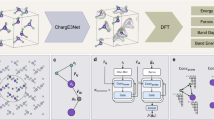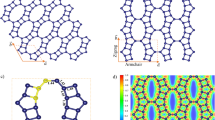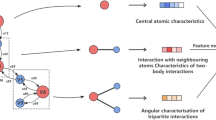Abstract
SYNTHETIC metals can be derived from graphite by intercalation of either electron donor or electron acceptor molecules between the carbon hexagon networks. In graphite, these networks are in effect macromolecules with aromatic character. Planar sheets of carbon hexagon networks lie parallel to the crystallographic a-axis of graphite, which has hexagonal symmetry. Physical properties in directions parallel to the networks are thus “macro-aromatic” properties. Perpendicular to these sheets, in the direction of the crystallographic c-axis of graphite, physical properties involve much weaker physical interaction between the layers; probably only van der Waals dispersion forces hold neighbouring sheets together in graphite crystals. It is comparatively easy to account for the high n or p electrical conductivities observed in the direction of the a-axis (as a consequence of charge transfer to or from the graphite electron bands1) but effects of such charge transfer on electrical properties in the direction of the c-axis of the crystals cannot be predicted as readily. Even in the parent graphite, the anisotropy ratio of electrical conductivity σa/σc is about 4 × 103 for well aligned stress recrystallized material2. It is possible that the relatively poor conduction of electricity in the c-axis direction in pure graphite involves a different kind of mobility, akin to electron hopping in crystals between molecules of poor conductors. In the synthetic metals the charged carbon hexagon networks are separated by positively charged layers of potassium atoms as in C8K (ref. 3) or by negatively charged layers whose molecular composition is given by formulae such as C24+ HSO4− 2H2SO4, C24+ NO3− 3HNO3, C8Br, C8ICl and so on. As far as conduction mechanisms in the c-axis direction are concerned, it is significant that considerable crystal swelling accompanies this intercalation; the repeat distance between successive sheets of carbon atoms increases from 3.35 Å in the parent graphite to a much larger separation, which is about 8 Å for graphite bisulphate4.
This is a preview of subscription content, access via your institution
Access options
Subscribe to this journal
Receive 51 print issues and online access
$199.00 per year
only $3.90 per issue
Buy this article
- Purchase on SpringerLink
- Instant access to full article PDF
Prices may be subject to local taxes which are calculated during checkout
Similar content being viewed by others
References
McDonnell, F. R., Pink, R. C., and Ubbelohde, A. R., J. Chem. Soc., 191 (1951).
Spain, I., Ubbelohde, A. R., and Young, D. A., Phil. Trans. Roy. Soc., A, 262, 345 (1967).
Murray, J. J., and Ubbelohde, A. R., Proc. Roy. Soc., A, 312, 371 (1969).
Ubbelohde, A. R., and Lewis, F. A., Graphite and its Crystal Compounds, 133 (Oxford University Press, 1960).
Blackman, L. C. F., Mathews, J. F., and Ubbelohde, A. R., Proc. Roy. Soc., A, 312, 371 (1960).
Moore, A. W., Ubbelohde, A. R., and Young, D. A., Proc. Roy. Soc., A, 280, 153 (1964).
Ubbelohde, A. R., J. Chim. Phys. (No. spécial), 64 (1969).
Ubbelohde, A. R., Proc. Roy. Soc., A, 309, 297 (1969); A, 321, 445 (1971).
Lee, P. A., Said, G., and Davis, R., Solid State Comm., 7, 1359 (1969).
Ogorodnik, A. D., Stakhira, I. M., and Tovstyuk, K. D., Soviet Physics Semiconductors, 3, 717 (1969).
Author information
Authors and Affiliations
Rights and permissions
About this article
Cite this article
UBBELOHDE, A. Anisotropy of Synthetic Metals. Nature 232, 43–44 (1971). https://doi.org/10.1038/232043a0
Received:
Revised:
Issue date:
DOI: https://doi.org/10.1038/232043a0
This article is cited by
-
Influence of hydrogenation on properties of layered crystals of gallium and indium monoselenides
Materials Science (2011)
-
Laboratory fundamental data
Space Science Reviews (1972)



